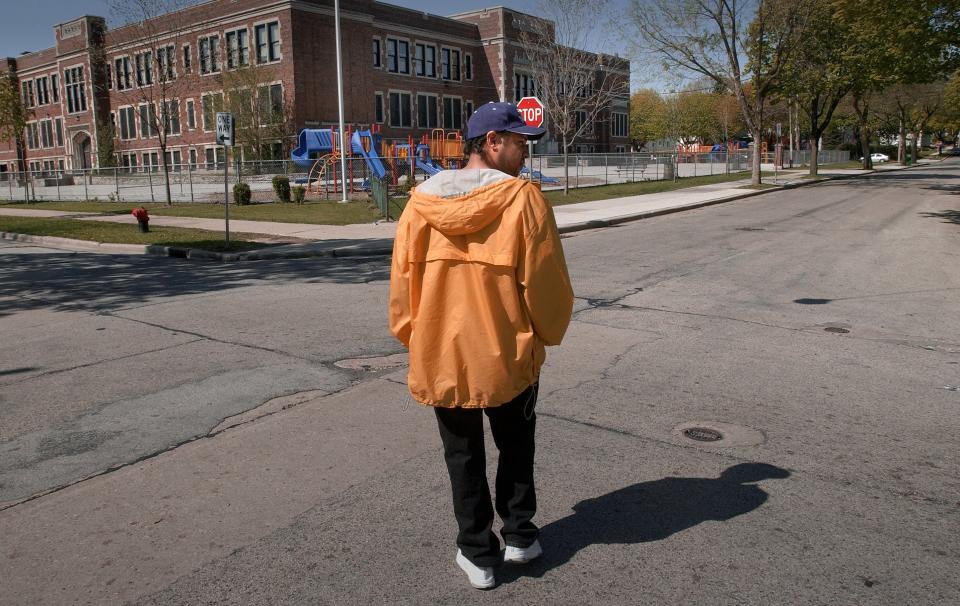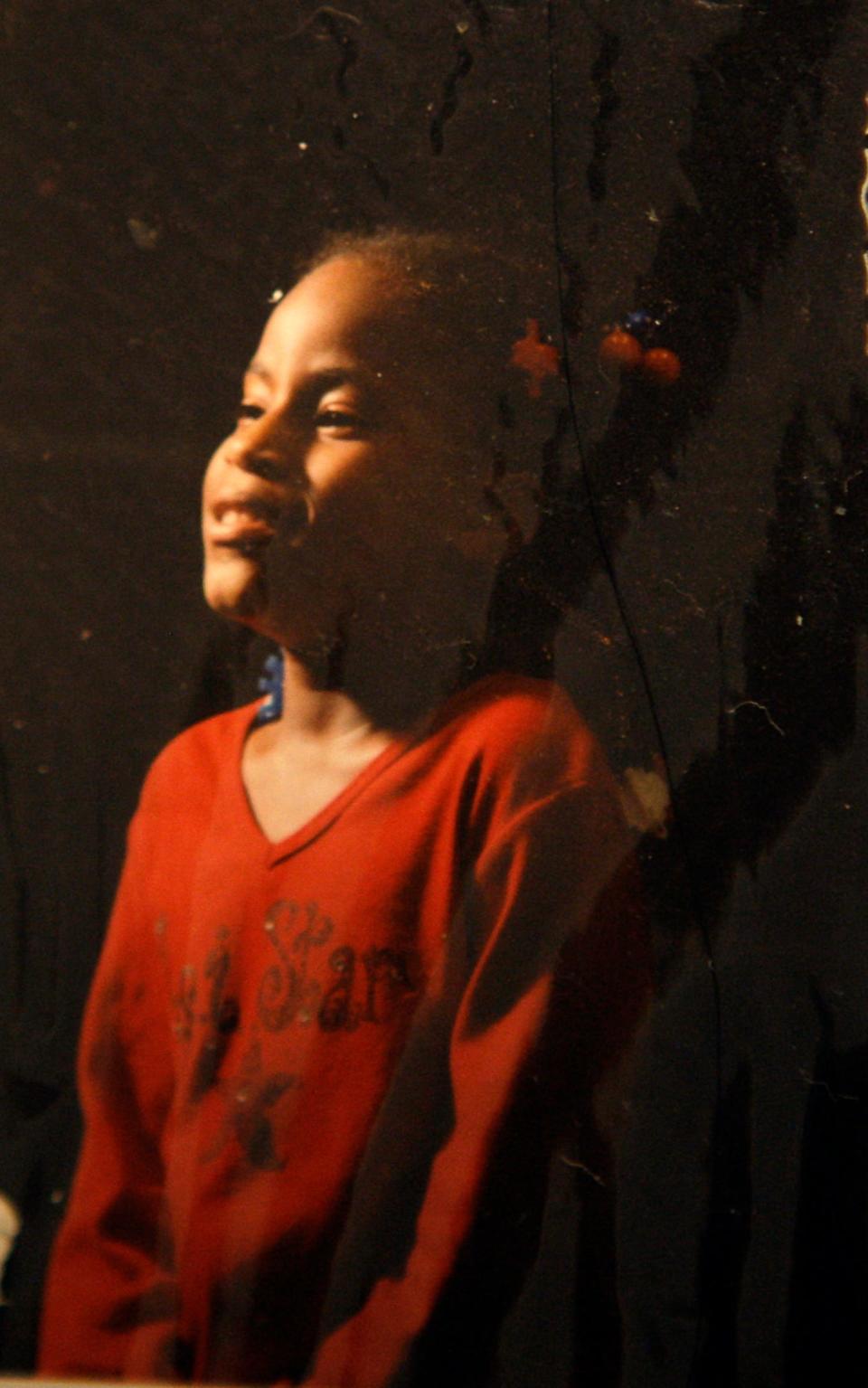Police records tell two stories about the fate of Alexis Patterson. This is one of them.
Editor's note: This is one of two linked stories based on the Alexis Patterson case file from the Milwaukee Police Department. Each story explores a different theory about her disappearance. Please start by reading the introduction.
When a child goes missing or is found dead, investigators focus on their family.
It’s simple statistics: The youngest homicide victims often are killed by their parents.
Alexis Patterson’s mother and stepfather, Ayanna Patterson and LaRon Bourgeois, have been considered suspects since her disappearance in 2002.
“Every tip we had came back to that family and it became apparent that something tragically went wrong in that house,” said Steve Spingola, a retired homicide lieutenant who worked the case.
Patterson disputes this. In a recent interview, she said police didn’t seem to care about what happened to her daughter. Instead, she believes they were fixated on trying to pin Alexis’ disappearance on Bourgeois because of his criminal history.

Bourgeois was well-known to police long before Alexis vanished.
In 1994, a gunman robbed a suburban Milwaukee bank, fatally shooting Glendale Police Officer Ronald Hedbany as he fled. The case remained unsolved for four months until a woman called in a tip.
The woman proved her credibility with a detail never released to the public: the exact amount of money stolen from the bank. She identified the gunman as Booker Shipp and said Bourgeois had served as his getaway driver.
Even with the woman’s statement, investigators didn’t have enough evidence to charge anyone.
Bourgeois became the key. The prosecutor offered him immunity if he confessed and testified against Shipp. Bourgeois took the deal.
Shipp went to prison for life. Bourgeois went free.
In the decade afterward, Bourgeois met Patterson and became a stepfather to Alexis. His son from a previous relationship moved in with them. About six months before Alexis disappeared, Bourgeois and Patterson had a baby together.
Multiple people told police Bourgeois sold drugs from the family’s home. Many people also said Patterson used drugs.
In recent conversations with a reporter, Patterson denied having a drug problem, but admitted using marijuana. She also said numerous other incidents depicted in the police reports had been exaggerated or had not occurred at all.
Several people talked about Patterson’s violent outbursts with children, including her daughter, according to newly-released police records.
One relative told police that a year earlier, Patterson hit a young girl named "Sharay" and knocked out her tooth. After someone called police, Patterson and others hid the child under a pile of clothing, the relative said.
A family friend said he had seen Patterson “hit Alexis violently numerous times usually across the face and about the body with her hand” and call her a “little bitch,” according to the police report.
Alexis’ stepbrother said Patterson had previously hit Alexis with a black belt. A cousin told police the same thing.

What happened at the time of Alexis’ disappearance
The morning Alexis disappeared, she and her mother argued over cupcakes. Alexis had planned to bring the treats to school, but she hadn’t done her homework, so her mother didn’t let her.
Patterson said Alexis was upset and had “fire" in her eyes, a report says.
Bourgeois told police he and his son walked Alexis to the corner between their home and the school and left her with a crossing guard, who — according to the records — was a fifth grader.
The reports include differing witness accounts. Some said they saw Alexis on the school grounds that morning. Others said she had never arrived.

One sixth-grade student told police she saw Alexis on the school steps with her head down. Alexis mentioned the cupcakes and the older girl offered to buy her one from a store.
“I want to get my own,” she remembered Alexis replying.
Alexis stood up and walked out of the schoolyard, she said.
Bourgeois told police that after he left Alexis with the crossing guard, he drove his son to the bus stop. His son said that didn’t happen. His father drove him to school, the boy told police. The bus driver backed that account, saying the boy wasn’t on the bus.
The boy also told police Alexis “got a whooping” from her mother that morning because she pretended not to know how to put on her socks. He said Patterson hit Alexis on the arm.
At first, Patterson denied she had physically disciplined her daughter. Four days later, she told police she “probably popped her that morning” and then, “I popped her,” meaning she hit or spanked Alexis, according to a police report.
She also said she “probably lied about that to the detectives previously,” the report says.

Phone records show a brief call from Patterson’s cellphone to the Family Services Department of St. Michael's Hospital at 9:37 a.m., about an hour after Bourgeois said he left Alexis with the crossing guard.
The hospital had no record of anyone talking to her, according to the police reports, which don’t indicate whether police asked Patterson about the call. In a conversation with a reporter, Patterson said her new baby’s pediatrician practiced out of that department. She called for advice because the baby was coughing, she said, but hung up after being placed on a long hold.
That afternoon, a neighbor and her sister stopped by to see Patterson and the baby. The neighbor told police Patterson barely let them into the house and rushed them out to the porch to smoke. She said Patterson admitted to giving Alexis a "real bad whooping” the night before.
Two weeks after Alexis went missing, FBI behavioral analysts concluded she was most likely the victim of an “emotion-based” homicide at the hands of her mother. Also possible, but less likely, they said, was that she had been the victim of a neighbor.
The analysts noted numerous “discrepancies” in Patterson's and Bourgeois’ statements to law enforcement, friends and media, including the times they said they had met with various people the day of the girl’s disappearance and whether they had visited Patterson’s grandmother.
The FBI recommended that Milwaukee police conduct a forensic analysis.
They brought in a cadaver dog. These kinds of dogs are trained to give a signal, often sitting or sometimes barking, when they detect the odor of human remains. In this case, the dog alerted on the trunk of Bourgeois’ car and the family’s basement.

Investigators then sprayed those areas with luminol, a chemical that can reveal traces of blood and other substances, including bleach. It lit up everywhere the dog had hit. Police swabbed the illuminated spots, but lab testing did not find blood.
Both Patterson and Bourgeois agreed to take polygraph tests.
Polygraphs are not admissible in criminal court in Wisconsin because they are considered unreliable. However, police and private investigators still use them as investigative tools.
The Milwaukee Journal Sentinel reported in 2002 that Bourgeois “failed” his polygraph test, something he denied publicly. The reporter who broke that news, James Burnett, stands by his story.
Because of tight state laws governing polygraph results, the tests were not released with the case file in response to the recent public records request from the Journal Sentinel and USA TODAY.
Regardless, the police reports indicate investigators considered the polygraph results a clue that pointed toward Alexis’ family.
What police learned in the months and years after Alexis went missing
About a month after Alexis went missing, in June 2002, one of Patterson’s friends said she overheard a telephone call between Patterson and her mother, according to an account she gave to police later that year.
The friend, who was at the mother’s house, picked up the extension and listened in on the conversation.
At one point, the mother told Patterson, “You should have never whipped Alexis.”
Patterson allegedly replied: “I whipped her and she didn’t get back up.”
The mother became angry and threw the phone, the friend said.
In August 2002, a detective witnessed Patterson losing her temper after he stopped by a combination hair salon and candy store she had opened with Bourgeois.
Patterson believed police were not trying to find her daughter and became enraged, the detective’s report says, clenching her fists, knocking over candy, throwing a fan at the wall and saying she would put a knife in someone’s throat.
“Ayanna again stated that people should understand not to upset her and that when they do someone will get hurt,” the report says.

Investigators also were told that Patterson had failed to return a large duffle bag she had borrowed from a friend. The woman told them the bag was large enough to hold a body.
In an interview this week, Patterson said she borrowed a small tote bag, not a large duffle bag.
Patterson also has recently told police and reporters that she spanked Alexis a a couple of days before her disappearance, but not the day she was last seen.
“Let me be clear. I never popped her that morning,” Patterson told Detective Timothy Keller in a March 2022 call that was recorded.
“She got a pop. She got her ass whipped the day before,” she continued. “Not the day before, but the day before that.”
She said she had a good reason: Alexis had been caught by her teacher talking to an unknown woman behind the school — not just once, but twice.
No one had ever mentioned the mysterious woman to police before — not Patterson and not the teacher, both of whom had been interviewed extensively in 2002.

When Keller asked the teacher about this new clue, the teacher did not remember Alexis talking to an unknown woman.
She said if such a situation had occurred, she would have told police at the time.
Putting the pieces together
Under this theory, here's what police believe might have happened:
The morning Alexis disappeared, she and her parents argued about whether she could bring cupcakes to school. Her mother didn’t allow it, and Alexis became upset.
Bourgeois handed Alexis off to the crossing guard. But the 7-year-old did not go inside the school. Instead, she headed back home to get her cupcakes.
In this theory, either Bourgeois or Patterson or both physically disciplined Alexis for returning. The beating went too far, and the girl was fatally injured.
As Alexis lay bleeding in the basement, someone called the hospital, but hung up when they realized she was dead. Then her stepfather, mother or someone else put Alexis’ body into the duffle bag, moved it to the trunk of Bourgeois’ car and drove away to dump her body.
Later that morning, her stepfather and mother doused the car and basement with bleach to remove the blood.
The takeaway: Two theories and no clear answers
Put yourself in the position of a detective or a prosecutor. You need to rule out all other possibilities before arresting or charging someone.
That would be extremely difficult in this case.
The police reports are full of interviews with witnesses who contradict one another. Did Alexis make it across the street on the morning she went missing? Did she ever get to the playground? Was she really sitting on the steps of the school sulking about the cupcakes? There’s no clear answer to any of those questions.
The two leading theories both conclude that Alexis is likely dead, but her remains have never been found. No one has ever confessed to taking her, let alone killing her. And there is little physical evidence to support either theory.
If you believe Alexis’ parents were involved, you would have to ignore the dozens of witnesses who came forward about the drug ripoff and kidnapping theory.
You would also have to explain her mother’s actions in the years since Alexis disappeared. If her parents were involved, why would her mother continue to raise awareness about the case? Why would she continue to insist a woman in Ohio is her daughter, despite DNA testing that proves she’s not?
Alexis’ stepfather died of a drug overdose in 2021. Before that, he had been offered immunity to tell police and prosecutors what happened to her. He had made a deal with prosecutors in the bank robbery case years earlier. If he knew who took Alexis, why wouldn’t he do it again?
If you believe Alexis was abducted by a drug supplier, you would have a problem with witness credibility. Most of the people who provided information about a revenge kidnapping were inmates who were trying to get out of their own legal trouble in exchange. That’s a solid motive to lie.
Although the men implicated in the alleged plot were seasoned criminals, they sold drugs and committed armed robberies. That’s a world away from kidnapping and killing a child.
If Bourgeois’ drug supplier were to be charged, his defense attorney would have more than enough reasonable doubt to win an acquittal. A lawyer could cast suspicion on Alexis’ parents with the call to the hospital, their inconsistent stories and the luminol testing that indicated possible blood or bleach in the basement.
What’s more, a defense attorney could cite dozens of tips from people who said they saw Alexis alive in the weeks, months and even years after she went missing.
Unlike many of the other investigators who worked the case, retired Milwaukee police detective Kathy Spano never settled on one theory or the other.
“We develop these deep feelings and biases during our investigation. I'm not talking about race. I'm talking about theories of an investigation,” she said.
“You have to really be good at not jumping to a conclusion or forming an opinion based on some of the past experiences you have on this job,” she added. “It's a challenge to do that, but it’s so important for law enforcement.”
No case is truly unsolvable — not even this one. Someone knows what happened to Alexis.
“Everybody needs a little bit of hope,” Spano said. “We’re not God. We don’t know for sure that a case won’t be solved or that someone won’t be found.”
Anyone with information about Alexis Patterson is asked to contact Milwaukee police at 414-935-7360. To remain anonymous, contact Crime Stoppers at 414-224-TIPS or use the P3 Tops app.

This article originally appeared on Milwaukee Journal Sentinel: One theory about what happened to Alexis Patterson

